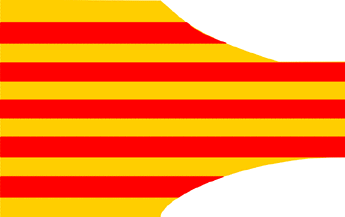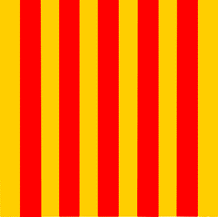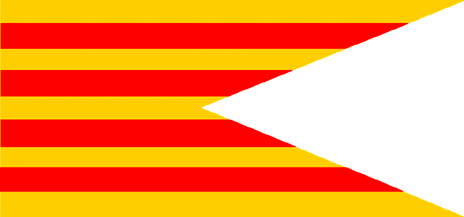PART IV
Return to the three golden pales.
After Jaume I's death, the kingdom was divided between his two sons: the oldest, Peter II the Great, received the main territories, with the dynastic capital Barcelona and all Catalonia including most of the vasal counties of Barcelona, and the adjacent kingdoms of Aragon and Valencia. To the second son, James II, corresponded the Kingdom of Majorca, the counties of Cerdanya and Roselló and the fief of Montpellier. Since James II possessed the kingdom as fief of Peter II, the flag used was the same in both kingdoms. The return to the three pales would explain the appearance of documents of this type later than 1241 when James I adopted the five pales
Four golden pales
There is no record of any modification of the senyera in the period of ten years when Peter and his successors occupi ed the states of James II (1285-1295/98). Peter the Great had conquered Sicily in 1282 (after the Sicilians revolted in favor of Catalonia), and this would be the origin of the ancient use of red and golden bars in Sicily (red and yellow colors remain in its current flag), since the king decreed that be Sicily be represented by the Catalan bars alternated with the black eagles of Sicily. With the incorporation of Sicily the fourth golden pale (according to Narcis Sentenach) would be added.

Five golden pales
Peter died in 1285 and was succeeded by his son Alfons. The kingdom of Sicily passed to other son called James. Perhaps the bars were not modified since king Alfons died in 1291. His brother James of Sicily was proclaimed king of the Catalan c ounties, Valencia and Aragon (James II) and in 1295 renounced Sicily receiving in exchange Corsica and Sardinia, whose conquest to the Genoeses was long, ending the conquest of the second in 1325, little before his death (1327). He was succeeded by his s on Alfons and this (1335) by his son Peter III of Catalonia, IV of Aragon and II of Valencia who acquired Majorca in 1343, and Rosselló and Cerdanya in 1344 (Montpellier was sold by James III of Majorca to the French king in 1349). In the royal seals of this era always appear five golden bars and four red.
The reincorporation of Sicily to the Catalan crown took place in 1377. With this Peter was ruling over the Principality (central nucleus and the more important part and of greater category of h is dominions), five kingdoms (Aragon, Majorca, Valencia, Sardinia, and Sicily) and several other territories (counties, duchies, vice-counties and fiefs) that ranked at least to a Kingdom; thus the golden bars would have to be at least seven, but in fac t ther is only record that by this era was added a sixth bar (European - American Encyclopedia) that in any case there would disappear in 1392 when his son and succeesor John ceded the Kingdom of Sicily to his son Martín. In John II's reign (1458-1479) appears again in seals the use of six golden bars, apparently due to the fact that he was king of Catalonia, Navarre, Aragon, Sicily, Valencia and Majorca

Heraldic and sigilographic representation.

Since then (1392 - c.1460 and after 1478) the five gold bars and four of gules were used. Representations of the flag show it swallowtailed

The Catalan dynasty became extinct with John II. He was succeeded by a dynasty of Castilian origin quickly integrated in Catalonia. The last king of this dynasty, Ferdinand, upon becoming a widower of Queen Elisabeth of Castille, tried to preserve the independence of the territories of the Catalan crown and married with a princess of Foix, but, in spite of repeated attempts, they did not had male children and the house of Austria (dynasty that was already ruling in Castille) arrived to the Catalan throne, hardly showing consideration to the Catalan national symbology.